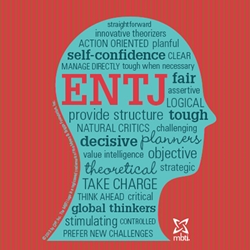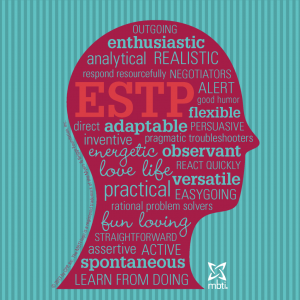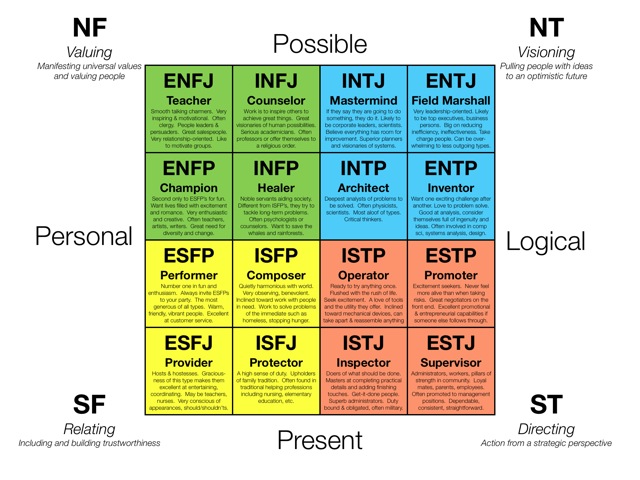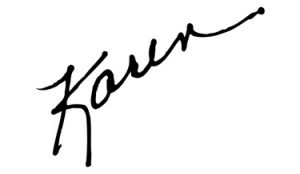
You may have learned about personality assessments back in Psychology 101 or your organization’s HR department.
Over the past 20 years, The Wunderlin Company has come to believe that the right personality assessments, when used the right way, can be a valuable tool for individuals and organizations.
So how can you use them well – and how do they sometimes get abused in practice?
Read on – and then, please share your own experiences.
‘Sorry, can’t do that – I’m an ESTP/Red/Low D.’

A look at the uses (and abuses) of workplace personality assessments
If you’ve been on the job for a while, the odds are good that you have been part of an exercise aimed at giving you insight into your personality and how you operate at work.
You may have memorized new letters like “ENTJ” after taking the Myers-Briggs Type Indicator. Your work team’s personalities may have been categorized by color — Blue, Yellow, Red, and Green. You may have been labeled on a continuum with language like low to high challenge – or told that you are a “high B.”
With luck, the assessment paid off: Assessments are genuinely valuable when they help us become more self-aware and more able to understand how colleagues are similar to us – and different.
Ideally, that understanding helps us work together more effectively and benefits our organizations.
But there can also be a darker side to personality assessments.
The colleague who shrugs off a mistake and says, “I did it because I’m a high B.”
Or “…a Green.”
Or “…an N.”
The reality, of course, is: “We chose to do it.”
We may have certain personality tendencies that make a choice easier and more natural. But at the end of the day, we are still in control of our own behavior.
Assessments are a tool, not a bible, a science or a religion. They offer a framework to examine how we operate and enrich our workplace understanding and conversation.
But they are never an excuse.
While assessments are used increasingly in hiring and orientation, according to The Wall Street Journal, which estimates 80 percent of mid-size and large companies do so, they also have their skeptics – mostly those who believe they have been over-used or oversold.
A recent Fortune article warned of the risk of over-use and over-simplification, asking, “Have we all been duped by the Myers-Briggs?”
A Fast Company article entitled “Personality Tests: Back with a Vengeance” argues they should be viewed modestly as “learning tools.”
The Wunderlin Company finds assessments are most valuable as part of an executive coaching process, and as a way to help new or established teams function more effectively and productively.
Veteran counselor Ellen Shapira used this great simple description of their value:
“Some people talk the same language. Some people don’t.
“The big thing is to not view differences negatively. Learn how people operate differently from you– and you will work better together.
“As a result, the total becomes greater than the sum of the parts.”
Myers Briggs Type Indicator

The Wunderlin Company has long used the Myers-Briggs Type Indicator (MBTI) in its organizational development work and executive coaching. Developed over the past 50 years, the MBTI evaluates individual preferences along four key variables – Extroversion-Introversion, Sensing-Intuition, Thinking-Feeling, and Judging-Perceiving.
Many folks are familiar with the original “4-letter” version of the MBTI–using those four preferences to come up with a profile.
We have found the MBTI Step 2 to be a particularly useful version of this assessment. In Step 2, folks can “peel the onion” in layers to provide more nuanced and detailed information–for example, seeing within the Extroversion/Introversion scale five sub-scales to understand the unique ways we are actually a combination of preferences.
For example, in my own case, I have an overall preference for Thinking as a way to make judgments and decisions, but it turns out I am strongly accommodating, which is typically associated with a Feeling approach to making decisions. That subtle distinction is important.
When you consider the MBTI, understand that it’s not the latest wonder drug for workplaces. One of my colleagues calls it “the aspirin of personality testing” because of its longevity, wide use and proven track record of effectiveness.
In our experience, the MBTI:
- Helps team members understand their strengths and differences. There is almost always an “aha” moment.
- Encourages respect and promotes understanding so groups can leverage their diversity and work more effectively.
- Creates a common language to discuss work – “a shorthand that can be wonderful,” as my colleague Merrell Grant puts it.
- Encourages solutions to conflicts. As Merrell tells folks in training sessions, you can appreciate a different point of view more with a framework. There may be a fundamental difference in how you usually take in information and make decisions.
So you might be brainstorming solutions, for example, if that is your personality type; while a colleague may become impatient and want to quickly get to the bottom line plan of action.
Some team members may need a quiet break to assimilate new information and gather their thoughts. Others like give-and-take in a group.
There is no one right way to operate: With luck, understanding personality preferences leads to a respectful, collegial way to solve problems and arrive at sounder conclusions because different perspectives are heard.
If you have read Patrick Lencioni’s best-selling fable, “Five Dysfunctions of a Team,” odds are you will see how understanding personality differences through a tool like Myers–Briggs can help diverse team members develop trust, commitment, and accountability.
One aspect of the MBTI and most other assessments can be tricky:
The words in their descriptions usually mean something more precise and rich than the everyday language for, say, “sensing” and “intuition.”
So it’s important to have an experienced interpreter to explain results.
And, once in use in your workplace, it helps to get a periodic “tune-up” to see how it’s playing out in the organization’s everyday operations.
A New Tool to Dig Deeper–Birkman
The Wunderlin Company also uses The Birkman Method, a personality assessment that offers a more complex multi-dimensional perspective.
Developed more than 50 years ago by Roger Birkman, a World War II pilot and Ph.D., The Birkman offers a perspective on your interests – what you like to do and where you prefer to direct your energies. Keep in mind that interests can be different from your skills and aptitudes.
The Birkman also offers 11 Components that describe behavioral preferences. A unique aspect is that it offers this behavioral assessment information in three contexts: Usual behavior, that is, how you go about getting things done; your needs, that is, how you want to be treated, supported and motivated; and your behavior under stressful conditions, when you are feeling frustrated and your needs are not being met.
You might usually be very direct and candid in your communication with others, for example. But you might need others to treat you differently–to be more nuanced and gentler in communication with you–a tendency colleagues are unlikely to discover by seeing how you behave.
Similarly, you may appear to prefer a conventional, cautious approach to new ideas, but what you need to motivate you is an environment where you can take on some personal risk and think outside-the-box.
The Birkman facilitates team-building, executive coaching, leadership development, career management and interpersonal conflict resolution. It can help evaluate career opportunities as well as organizational cultures. We believe it provides a useful complement to the MBTI.
The Hogan: New Perspectives
In 1980 doctors Robert and Joyce Hogan introduced the first assessment to measure personality designed specifically for business applications. Since that time, Hogan has leveraged its strong research–based assessment capabilities to deliver the Hogan Leadership Series, a suite of assessments:
- The Hogan Potential Inventory provides information regarding personality characteristics that appear during social interaction and that help or inhibit your ability to get along with others and achieve our goals. In short, it describes how others would describe you. It does not provide information regarding how you see yourself. Results are useful information in evaluating job fit.
- The Hogan Development Survey, also known as the Challenge Report, provides information about the dark side of personality. It describes behaviors that are likely to emerge for you under periods of stress and may disrupt productive working relationships or derail your effectiveness. The results are useful in evaluating job fit as well as input to individual and team development.
- The Hogan Motives, Values and Preferences Inventory explores how well your values fit in with the rewards provided by an organization. Results will help you identify situations that will be motivating and personality satisfying.
There are also many other fine assessment tools. Here are some others you may find useful:
The Herrmann Brain Dominance Instrument uses a 120-question online test to determine how four styles of thinking shape how we operate — analytical, sequential, interpersonal and imaginative thinking.
The DiSC assessment also assesses personality over four dimensions — dominance; influence; steadiness and conscientiousness.
The FIRO-B (Fundamental Interpersonal Relationship Orientation – Behavior) is based on the belief that when people get together in a group, three main interpersonal needs are central: affection/openness, control, and inclusion.
The Predictive Index is a popular proprietary assessment tool that measures the motivating behaviors and needs of individuals to help leaders get the most from employees and help teams become more effective.
What to Do (and What Not to Do)
For most of us, assessment tools provide a useful gauge. Their use in workplaces almost always results in more of those “aha” moments I mentioned earlier:
“Now I know why my boss is bugged when I do this.”
“So this is why I have problems communicating with this coworker.”
“Almost everyone in my office tends towards introversion. Maybe that’s why we don’t get more give-and-take at meetings.”
At the same time, no matter how venerable the test or how impressive its rigor or how enthusiastic its testimonials, it is important to recognize that assessments are just one valuable learning tool in your arsenal as a leader.
At their best, they help us enhance our skills: The heart of our work is still intuitive, insightful face-to-face interactions that shape effective teamwork everyday in our organizations.
What’s next?
Please share your experiences with assessment tools. Recommend your favorites and tell us why.
And please provide examples of ways they’ve worked wonderfully and pitfalls you’ve encountered.
Stay tuned: Our next newsletter will look at how assessment tools can help individuals at key junctures of their careers. Drop me a line if you would like to offer a personal story.



Leave a Reply